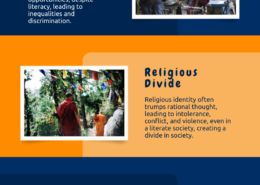Explain why the legalization of same-sex unions is being referred to as a matter of fundamental significance, highlighting current patterns in Indian marriages. (Answer in 150 words)
Explaining the Sex Ratio Disparities in Tribes and Scheduled Castes in India **1. Traditional Societal Structures Tribal societies in India often exhibit more equitable gender roles compared to Scheduled Castes (SCs). Many tribes, such as the Munda and Gond, have traditionally practiced more egalitaRead more
Explaining the Sex Ratio Disparities in Tribes and Scheduled Castes in India
**1. Traditional Societal Structures
Tribal societies in India often exhibit more equitable gender roles compared to Scheduled Castes (SCs). Many tribes, such as the Munda and Gond, have traditionally practiced more egalitarian social norms where women have significant roles in decision-making and family structures. For example, in the Naga tribes, women have substantial economic and social responsibilities, contributing to a more favorable sex ratio.
**2. Cultural and Social Practices
Tribal communities frequently engage in practices that ensure better protection and respect for women. In contrast, Scheduled Castes have historically faced more rigid caste-based social structures that often perpetuate gender discrimination. For instance, in some SC communities, the impact of deep-rooted patriarchal norms and socio-economic disadvantages has led to a less favorable sex ratio.
**3. Access to Healthcare and Education
Tribal areas, though often isolated, sometimes benefit from community-driven health and education initiatives that contribute to better sex ratios. Recent programs aimed at improving healthcare access and educational opportunities in tribal regions have positively impacted the sex ratio. In contrast, SC communities may face challenges such as limited access to healthcare and lower educational attainment, which can adversely affect gender ratios.
**4. Recent Statistical Trends
According to the Census of India 2011, the sex ratio in many tribal areas is higher than in SC communities. For example, the sex ratio among the Bhils and Santhals is notably more favorable compared to SCs like the Pallars and Chambars, who exhibit lower sex ratios due to socio-economic factors and historical discrimination.
**5. Government Initiatives and Interventions
Recent government initiatives, such as the National Health Mission and educational programs aimed at SCs, are working to address disparities. However, persistent socio-economic challenges continue to impact sex ratios negatively in SC communities.
In summary, the more favorable sex ratio in tribal communities compared to SCs can be attributed to their traditional egalitarian practices, better community health initiatives, and comparatively equitable gender roles. In contrast, SC communities face socio-economic and cultural challenges that contribute to less favorable sex ratios.
See less

Marriage is an institution admitting men and women to family life, with the implied purpose of parenthood and establishment of a family. The institution has social approval and religious sanction. But, in the present times, the meaning of marriage and relationships is starting to change. The major cRead more
Marriage is an institution admitting men and women to family life, with the implied purpose of parenthood and establishment of a family. The institution has social approval and religious sanction. But, in the present times, the meaning of marriage and relationships is starting to change.
The major changes observed in the matrimonial system in India can be identified as follows:
The most recent trend with respect to the marriage system in India is related to the issue of same-sex marriages. The Supreme Court of India has received multiple petitions for legal recognition of same- sex marriages under the Special Marriage Act, 1954 and to extend the right to the LGBTQIA+ community by making marriage between any two persons gender- neutral.
The issue is of seminal importance due to the following reasons:
At the same time, there are certain concerns with respect to legalizing of same-sex marriage, such as:
Enforcing same-sex marriage in a diverse country like India will not be easy as the structures and attitudes entrenched over generations will require a conscious attempt to open minds in order to change.
See less